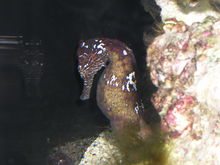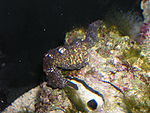- Hippocampus kuda
-
Hippocampus kuda Seahorse Scientific classification Kingdom: Animalia Phylum: Chordata Class: Actinopterygii Order: Syngnathiformes Family: Syngnathidae Genus: Hippocampus Species: H. kuda Binomial name Hippocampus kuda
Bleeker, 1852[1]Hippocampus kuda, also known as the common seahorse, is a member of the family Syngnathidae of the order Syngnathiformes. The common sea horse is a small, equine-like fish, with extraordinary breeding methods.[2] Greeks and Romans believed the seahorse was an attribute of the sea god Poseidon/Neptune, and the seahorse was considered a symbol of strength and power. Europeans believed that the seahorse carried the souls of deceased sailors to the underworld - giving them safe passage and protection until they met their soul's destination.[3] The common seahorse is considered a vulnerable species.[1]
Contents
Reproduction
The male carries the eggs in a brood pouch on his lower abdomen. After courtship the pair come close together so that the female's oviduct is close to, if not resting on, the brood pouch of the male, and the female expels some eggs into the pouch. This happens several times until spawning is complete. The male then wiggles about, as if to rearrange the eggs within his pouch. The exact point at which fertilization takes place is not known, though many assume that it occurs while the eggs are in the pouch. The incubation period is generally four to five weeks. To "give birth" the male bends forwards and then backwards, thrusting his pouch forward expelling one or two youngsters with explosive force. Raising the fry in an aquarium is difficult, as they require a large amount of minuscule live food.[4]
Range and habitat
The common seahorse inhabits shallow coastal waters throughout the Indo-Pacific oceans.[2] Wild seahorse live mainly among coral reefs, and shallow estuaries. They use their tails to anchor themselves to coral branches.[4]
Physical description
The sea horse's swimming position is vertical, with slight forward or backward inclinations, in the direction of travel. The body is covered with armored plates. An equine-like head set at right angles to the body ends in a long tubular snout. A bony "coronet" may develop on the head.[2] The male seahorse broods fertilized eggs in a small pouch in its lower abdomen. Females are slightly smaller.[2]
In aquaria
Common seahorses have very small mouths, eating only small animals like brine shrimp and even newborn guppies. Seahorses need to eat frequently—4-5 times a day. Many aquarists who have kept this species cultivate their own brine shrimp, and rotifers. Daphnia is eaten when other foods are unavailable.[4]
Seahorses spend most of their time anchoring to coral reefs and branches with their tails, made necessary because they are poor swimmers. The need similar anchor points In aquaria. Seahorses like a quiet tank, without large, belligerent fish, and a slow-moving current. Aquarists have found them to be generally accepting of tankmates like Siniperca (Mandarin fish) and other bottom dwelling fishes.[4]
Temperature, pH, and salinity
Common seahorse generally do best at a temperature of 72–77 °F (22–25 °C), optimally 73–75 °F (23–24 °C). They do not tolerate even spikes above 80 °F (27 °C) well.[5] Their optimal pH range is around 8.1-8.4.[6] The common seahorse can tolerate a range of salinity from 18 parts per thousand (ppt) to 36 ppt but salinity below about 25ppt should be promptly corrected. About 32 ppt is ideal.[7]
References
- ^ a b "Hippocampus kuda". IUCN red list of threatened species. International Union for Conservation of Nature. 2008. http://www.iucnredlist.org/apps/redlist/details/10075/0/full.
- ^ a b c d Mills, Dick. Aquarium Fish: The visual guide to more than 500 marine and freshwater fish varieties. Eyewitness Handbooks. p. 281.
- ^ Venefica, A.. "Symbolic Meaning of the Seahorse". Whats-Your-Sign.com. http://www.whats-your-sign.com/symbolic-meaning-of-the-seahorse.html.
- ^ a b c d Bailey, Mary; Gina Sandford. The Ultimate Encyclopedia of Aquarium Fish & Fish Care. p. 239.
- ^ Giwojna, Pete (16 January 2006). "Re:KH is killing me!". Seahorse Forums. Ocean Rider Club. http://www.seahorse.com/index.php?option=com_joomlaboard&Itemid=218&func=view&id=624&view=flat&catid=2.
- ^ Giwojna, Pete (6 January 2006). "Re:Maybe Seahorses?". Seahorse Forums. Ocean Rider Club. http://www.seahorse.com/index.php?option=com_joomlaboard&Itemid=218&func=view&view=threaded&id=614&catid=2.
- ^ "Setting up your seahorse aquarium". Seahorse Australia. http://www.seahorse-australia.com.au/pages/aquar_setup.html.
Categories:- Hippocampus
- Fish of Hawaii
Wikimedia Foundation. 2010.


